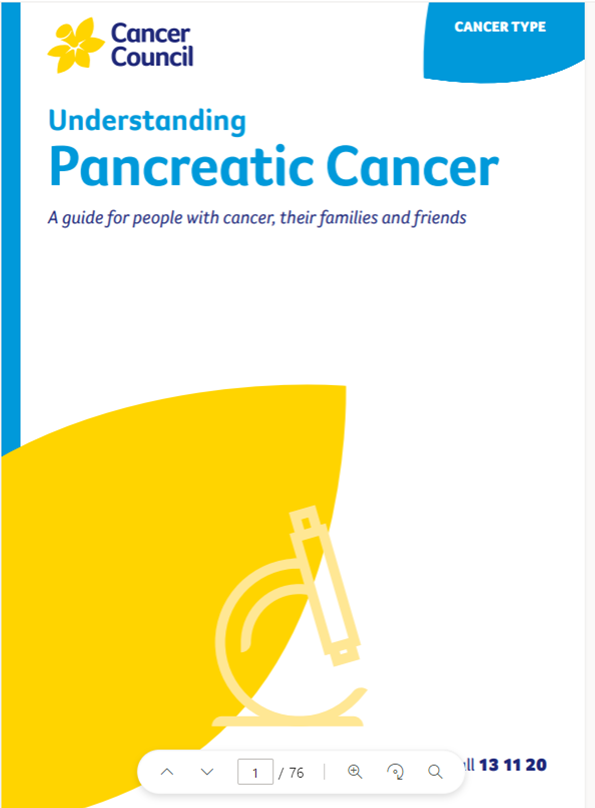- Home
- Pancreatic cancer
- Diagnosis
- Tests
- Tissue sampling
Tissue sampling for pancreatic cancer
If imaging scans show there is a tumour in the pancreas, your doctor may remove a sample of cells or tissue from the tumour (biopsy).
This is the main way to confirm if the tumour is cancer and to work out exactly what type of cancer it is. A specialist doctor called a pathologist will examine the sample under a microscope to check for signs of cancer. Sometimes, the results are not clear and a second biopsy is needed.
A biopsy can be taken in different ways, including:
With a needle
A sample of cells may be collected with a fine needle (fine needle biopsy), or a tissue sample may be collected with a larger needle (core biopsy). A fine needle or core biopsy can be done during an endoscopic procedure. Another method is to insert the needle through the skin of the abdomen, using an ultrasound or CT scan for guidance. You will be awake during the procedure, but you will be given a local anaesthetic so you do not feel any pain.
During keyhole surgery
Also called a laparoscopy or minimally invasive surgery, keyhole surgery is sometimes used to look inside the abdomen to see if the cancer has spread to other parts of the body. It can also be done to take tissue samples before any further surgery.
Keyhole surgery is done under general anaesthetic, so you will be asked not to eat or drink (fast) for 6 hours beforehand. If you take blood-thinning medicines or have diabetes, let your doctor or nurse know before the surgery as they may need to adjust your medicines in the days leading up to the procedure.
The procedure uses an instrument called a laparoscope (a long tube with a light and camera on the end). The camera projects images onto a screen so the doctor can see inside your body. The doctor will guide the laparoscope through a small cut near your bellybutton. The doctor can then insert other instruments through other small cuts to take the biopsy.
You will have stitches where the cuts were made. You may feel sore while you heal, so you will be given pain medicine during and after the operation, and to take at home. There is a small risk of infection or damage to an organ with a laparoscopy. Your doctor will explain the risks before asking you to agree to the procedure.
During surgery to remove the tumour
If you are having a larger operation to remove the tumour, your surgeon may take the tissue sample at that time.
→ READ MORE: Molecular and genetic testing
Podcast: Tests and Cancer
Listen to more of our podcast for people affected by cancer
More resources
Prof Lorraine Chantrill, Honorary Clinical Professor, University of Wollongong, and Head of Department, Medical Oncology, Illawarra Shoalhaven Local Health District, NSW; Karen Baker, Consumer; Michelle Denham, 13 11 20 Consultant, Cancer Council WA; Prof Anthony J Gill, Surgical Pathologist, Royal North Shore Hospital and The University of Sydney, NSW; A/Prof Koroush Haghighi, Liver, Pancreas and Upper Gastrointestinal Surgeon, Prince of Wales and St Vincent’s Hospitals, NSW; Dr Meredith Johnston, Radiation Oncologist, Liverpool and Campbelltown Hospitals, NSW; Dr Brett Knowles, Hepato-Pancreato-Biliary and General Surgeon, Royal Melbourne Hospital, Peter MacCallum Cancer Centre, and St Vincent’s Hospital, VIC; Rachael Mackie, Upper GI – Clinical Nurse Consultant, Peter MacCallum Cancer Centre, VIC; Prof Jennifer Philip, Chair of Palliative Care, University of Melbourne, and Palliative Medicine Physician, St Vincent’s Hospital, Peter MacCallum Cancer Centre and Royal Melbourne Hospital, VIC; Lucy Pollerd, Social Worker, Peter MacCallum Cancer Centre, VIC; Rose Rocca, Senior Clinical Dietitian – Upper GI, Peter MacCallum Cancer Centre, VIC; Stefanie Simnadis, Clinical Dietitian, St John of God Subiaco Hospital, WA.
View the Cancer Council NSW editorial policy.
View all publications or call 13 11 20 for free printed copies.



